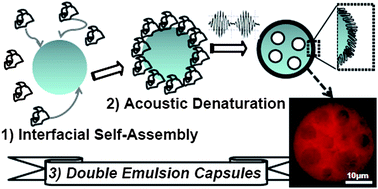Ultra-sound assisted formation of biodegradable double emulsion capsules from hen egg white†
Abstract
It was found that

* Corresponding authors
a
DWI an der RWTH Aachen e.V., Lehrstuhl für Makromolekulare Materialien und Oberflächen, RWTH Aachen University, Pauwelsstrasse 8, Aachen, Germany
E-mail:
boeker@dwi.rwth-aachen.de
Fax: +49 241-8023301
Tel: +49 241-8023304
It was found that

 Please wait while we load your content...
Something went wrong. Try again?
Please wait while we load your content...
Something went wrong. Try again?
P. van Rijn, H. Wang and A. Böker, Soft Matter, 2011, 7, 5274 DOI: 10.1039/C1SM05093A
To request permission to reproduce material from this article, please go to the Copyright Clearance Center request page.
If you are an author contributing to an RSC publication, you do not need to request permission provided correct acknowledgement is given.
If you are the author of this article, you do not need to request permission to reproduce figures and diagrams provided correct acknowledgement is given. If you want to reproduce the whole article in a third-party publication (excluding your thesis/dissertation for which permission is not required) please go to the Copyright Clearance Center request page.
Read more about how to correctly acknowledge RSC content.
 Fetching data from CrossRef.
Fetching data from CrossRef.
This may take some time to load.
Loading related content
